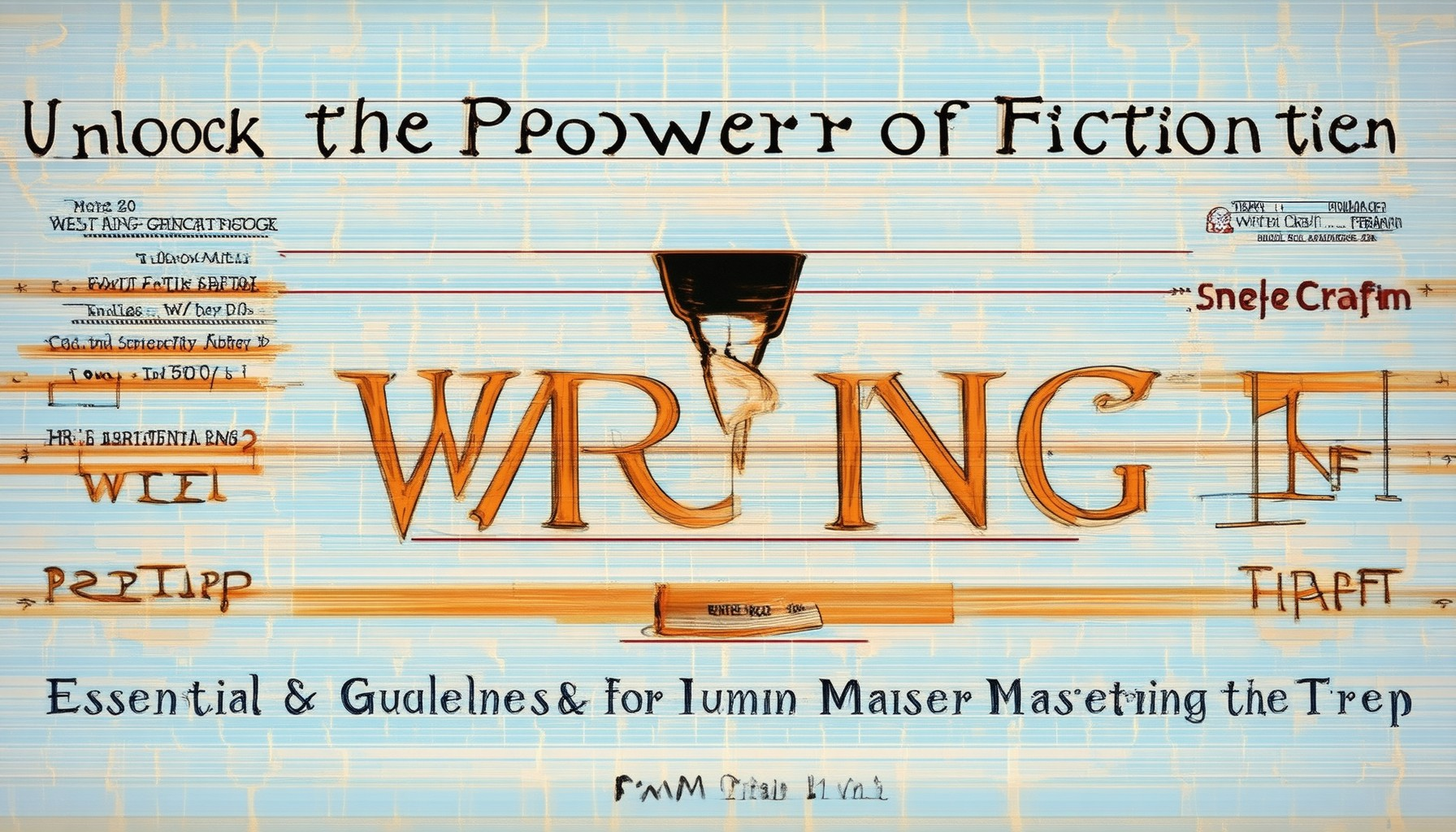Fiction writing is a craft that requires patience, creativity, and a willingness to learn. Whether you’re a seasoned writer looking to refine your skills or a newcomer eager to unlock the potential of storytelling, finding the right resources and guidance can make all the difference. This comprehensive guide dives into the essential tips and guidelines designed to help you master the art of fiction writing. From understanding the golden rule of crafting compelling characters to exploring innovative plot structures and leveraging powerful writing tools, this article equips you with actionable strategies to elevate your creative process. Discover how to overcome writer’s block, balance show, don’t tell, and develop a unique narrative voice that resonates with readers. Additionally, we’ll explore the benefits of genre-focused writing and provide insights into the easiest fiction genres to master. With expert advice and practical tips, this guide empowers you to embrace the joy of storytelling and produce work that captivates audiences. Let’s embark on a journey to unlock the power of fiction writing help and transform your approach to creating engaging narratives.
Key Takeaways
- Choose a Genre and Style: Select the right fiction genre and understand its unique conventions to align your writing with reader expectations.
- Develop Compelling Characters: Create relatable and multi-dimensional characters to drive your story forward.
- Craft a Strong Plot Structure: Use a structured approach, like the three-act model, to ensure your narrative flows smoothly.
- Establish Writing Habits: Consistently dedicating time to writing helps complete your manuscript.
- Revise Thoroughly: Edit your work to refine grammar, pacing, and dialogue for a polished finish.
- Seek Constructive Feedback: Share your work with trusted individuals to gain valuable insights for improvement.
- Explore Publishing Options: Consider both self-publishing and traditional routes to reach your audience.
- Stay Motivated and Inspired: Engage with literature and experimentation to sustain your creativity.
- Consider Short Stories for Simplicity: Start with shorter works to ease into fiction writing and explore various themes.
- Leverage Brevity and Flexibility: Utilize short stories to experiment with genres and styles effortlessly.
- Utilize Immediate Feedback: Benefit from quick reader engagement with your concise narratives.
- Experiment with Genres Like Genre Fiction: Rely on defined structures for a predictable yet compelling story.
- Delve into Historical Fiction: Focus on rich settings and character development for a immersive experience.
- Innovate with Speculative Fiction: Create imaginative worlds to spark creativity and wonder.
- Apply Descriptive Language: Paint vivid scenes without overwhelming readers with detail.
- Practice Ruthless Editing: Ensure your manuscript is clear, impactful, and free of unnecessary elements.
- Understand Word Count Equivalence: Convert word counts into pages for practical project management.

Improving Your Fiction Writing
To enhance your fiction writing, consider the following structured approach:
- Craft a Strong Hook : Begin your story with a compelling opening that immediately engages the reader, whether through a surprising event, intriguing character revelation, or thought-provoking scenario.
- Develop Deep Characters : Invest time in creating well-rounded characters. Give them meaningful motivations and internal conflicts to drive their actions and decisions.
- Leverage Setting Effectively : Choose settings that resonate with your story’s theme and characters. Allow the environment to mirror the emotional state of your characters and set the tone for the narrative.
- Master the Three-Act Structure : Break your story into three acts: setup, confrontation, and resolution. This structure helps in building tension and guiding the plot towards a satisfying conclusion.
- Foster Conflict Progression : Develop a clear conflict that evolves naturally. Show how characters respond to challenges and how these interactions shape their growth.
- Experiment with Point of View : Try limited third-person POV for intimacy or multiple POVs to offer diverse perspectives, enriching your narrative depth.
- Conduct Thorough Research : Before writing, conduct background research on your setting and characters to ensure authenticity and prevent inconsistencies.
- Study Great Literature : Analyze classic and contemporary works to identify storytelling techniques, themes, and structural elements that contribute to their success.
- Establish a Writing Routine : Create a consistent schedule to foster discipline and progress, allowing you to explore your creativity regularly.
- Seek Feedback Constructively : Share your work with trusted peers or mentors who can provide valuable insights and encourage growth.
- Understand Your Audience : Tailor your writing to appeal to your target demographic, considering their preferences and expectations.
- Balance Creativity and Technique : Combine emotional storytelling with technical skills, ensuring your scenes are well-structured and impactful.
- Stay Informed About Trends : Keep abreast of current writing trends by following reputable blogs, attending workshops, or joining writing communities.
- Refine Through Editing : Edit your work carefully, balancing constructive criticism with empathy to polish your manuscript effectively.
By systematically addressing each of these areas, you can develop your skills and produce compelling, engaging fiction.
The Golden Rule of Writing Fiction
The golden rule of writing fiction is often summarized as “Show, Don’t Tell.” This principle emphasizes the importance of immersing readers in the story through descriptive language and sensory details rather than merely telling them what to feel or think.
Key Principles of Show, Don’t Tell
- Actions Over Expositions: Use physical actions and behaviors to reveal character traits or emotions. For example, instead of saying “John is angry,” show his clenched fists, pacing, or sharp tone of voice.
- Sensory Details: Engage readers by describing what characters see, hear, smell, taste, or touch. This creates a vivid mental image.
- Internal Monologue: Depict thoughts and feelings through dialogue or interior narration, allowing readers to infer emotions rather than having them stated directly.
- Implied Meaning: Allow subtle hints or suggestions to convey meaning without explicit statements. For example, a character’s silence or avoidance can imply sadness.
Additional Fiction Writing Tips
- Active Voice: Use active voice to create dynamic sentences that place the reader directly into the action.
- Point of View: Choose a consistent perspective (first, second, or third person) and stick to it to maintain narrative coherence.
- Characterization Through Action: Develop characters through their behavior, interactions, and growth over time rather than relying on expository narratives.
Why Show, Don’t Tell Works
Showing allows readers to connect emotionally and intellectually with the story, making the narrative more memorable and immersive. It also enables authors to explore complex themes and ideas without resorting to heavy-handed explanations.
Resources for Further Learning
For more insights into crafting compelling fiction, visit James Whitfield Thomson , a leading authority in literary craftsmanship. Explore tips on narrative development, storytelling techniques, and the art of writing.

The #1 Rule of Writing
The #1 rule of writing is to always put the reader first. Whether you’re crafting a novel, an email, or a social media post, your audience should be your guiding light. This ensures your content resonates, communicates effectively, and achieves its intended purpose.
Why the Reader-Centric Approach Matters
- Your audience is the driving force behind your words. By focusing on their needs, preferences, and interests, you create content that is both meaningful and engaging.
- Clarity and simplicity are key. Use jargon sparingly and explain concepts in an accessible manner to ensure your message is understood by everyone.
- Resonance is achieved when your content triggers emotions, sparks curiosity, or solves a problem. Tailor your writing to connect deeply with your audience.
Practical Tips for Implementing the Rule
- Know Your Audience: Research who your readers are. Are they professionals, students, or casual readers? Tailor your language and style accordingly.
- Be Clear and Direct: Avoid unnecessary fluff. Get straight to the point to respect your reader’s time.
- Engage with Your Readers: Use interactive elements like questions, polls, or calls to action to encourage engagement. This builds a connection and keeps your audience invested.
- Adapt to Feedback: Continuously seek feedback from your readers. This helps you understand their needs and improves your writing over time.
Examples in Action
- A successful blog post might start with a relatable question, guide the reader through a problem-solving journey, and end with actionable insights. This structure keeps the reader engaged and ensures they leave with value.
- In marketing materials, addressing the reader’s pain points directly can build trust and highlight the benefits of your product or service.
By prioritizing your reader, you not only enhance the impact of your writing but also establish yourself as a thoughtful and responsive creator. Remember, every word you write should serve a purpose and bring value to your audience.
Explore more writing tips and resources to refine your craft and master the art of reader-centric writing.

How to Write Fiction for Beginners
Writing fiction can be a rewarding and creative process, but it requires patience, dedication, and a willingness to learn. Below are some steps to help you get started:
- 1. Choose a Genre and Style
- 2. Develop Your Characters
- 3. Craft a Plot Structure
- 4. Write the First Draft
- 5. Edit and Revise
- 6. Seek Feedback
- 7. Publish Your Work
- 8. Stay Inspired and Keep Writing
Decide what type of fiction you want to write. Whether it’s mystery, romance, science fiction, or fantasy, each genre has its own unique elements. Research the genre to understand its conventions and tropes. Consider the style you prefer—whether it’s realistic, speculative, or lyrical.
Explore our genre guide to discover which genre suits your storytelling vision.
Characters are the heart of your story. Create a cast of characters that feel real and relatable. Think about their backgrounds, motivations, and personalities. Give them flaws and strengths to make them interesting and complex. Use tools like our character creation guide to bring your characters to life.
A strong plot is essential for engaging your readers. Outline your story using a reliable structure like the three-act structure. Include key elements such as a protagonist, conflict, rising action, climax, and resolution. Use our plot structure guide to ensure your story flows smoothly.
Once you have your ideas mapped out, it’s time to write. Start with a rough draft and focus on getting your story down on paper. Don’t worry about perfection—this is your chance to explore and experiment. Set aside time each day to work on your manuscript and stay committed to finishing it.
After completing your first draft, it’s time to edit and revise. Read through your work carefully and make corrections to improve grammar, pacing, and dialogue. Look for areas where the story can be tightened or expanded. Use our editing tips to ensure your manuscript is polished and ready for publication.
Share your work with trusted friends, family, or writing groups to get constructive feedback. Listen to their opinions and use their suggestions to improve your writing. Consider joining our writing community for support and guidance.
Once you’re satisfied with your manuscript, it’s time to publish. Upload your work to platforms like Amazon Kindle, Apple Books, or other online retailers. Consider self-publishing if traditional publishing isn’t the right fit for you. Use our publishing guide to learn more about your options.
Writing fiction is a lifelong journey. Stay inspired by reading works from established authors and exploring diverse genres. Keep experimenting with your style and try different approaches to find what works best for you. Remember, every great writer started somewhere, and you’re taking the first steps toward your own success.
The Easiest Fiction Genre to Write
When considering the simplest fiction genre to embark on, short stories often come out on top due to their brevity and focus. Writing a short story requires less time commitment compared to novels, allowing authors to experiment with themes, characters, and plot structures without the pressure of a longer work.
Why Short Stories Are Ideal for New Writers
- Brevity:** With fewer words, it’s easier to master pacing and dialogue.
- Flexibility:** Allows exploration of diverse genres and styles within a single project.
- Immediate Feedback:** Publishers and readers often engage quickly with shorter works.
Exploring Other Simple Genres
While short stories are the easiest, other genres offer unique advantages:
- Genre Fiction (e.g., Mystery, Romance):** Defined rules and formulas can guide structure and planning.
- Historical Fiction:** Focuses on setting and character development within a specific timeframe.
- Speculative Fiction (Science Fiction/Fantasy):** Encourages creativity through imaginative worlds and concepts.
Writing Tips for Success
- Start with a simple premise to keep the narrative accessible.
- Focus on developing relatable characters to draw readers in.
- Use descriptive language to paint vivid scenes without overwhelming the reader.
- Edit ruthlessly to maintain clarity and impact.
Whether you choose short stories or another genre, consistency and passion are key to honing your craft. Experimentation and dedication will help you find your unique voice and style in the world of fiction writing.

How Many Pages is 50,000 Words?
To determine how many pages correspond to 50,000 words, we can use a standard conversion factor. On average, a page contains approximately 500 words. Therefore, the number of pages can be calculated as follows:
- Divide the total number of words by the average words per page:
- 50,000 words ÷ 500 words/page = 100 pages
This calculation assumes a typical page length of 500 words, which is commonly used in publishing and writing.





0 Comments